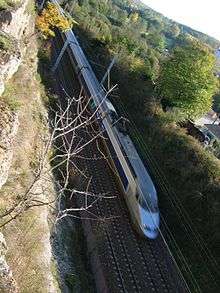LGV Sud Europe Atlantique

The LGV Sud Europe Atlantique (LGV SEA), also known as the LGV Sud-Ouest, is a high-speed railway line under construction between Tours and Bordeaux, in France. It will be used by TGV trains operated by SNCF, the French national railway company. It is an extension of the LGV Atlantique and is expected to enter service in mid-2017.
Purpose

The LGV SEA will bring high-speed rail service to southwestern France and connect the régions of Poitou-Charentes, Aquitaine and Midi-Pyrénées with the high-speed rail service of Northern Europe, which connects Paris to London, Brussels, Amsterdam and beyond. The trip between Paris and Bordeaux will take around two hours and ten minutes at a projected speed of 300 km/h. The inter-city links between Tours, Poitiers, Angoulême, and Bordeaux will also be improved and southwestern France will be better connected to various parts of the country and to the rest of Europe.
The project is also a response to the heavy traffic on the existing rail line. Train tracks are most efficiently used when all trains circulate at the same speed and have identical stops. The large speed difference between the fast TGV trains, which circulate on the existing tracks at speeds up to 220 km/h, and the slower freight trains and TER (regional) trains, which share the same track, forces to greatly increase the interval between these trains. This congests the tracks and prevents their most efficient usage.
Dedicated tracks for the TGV therefore leave space on the existing tracks for many more freight and TER trains than just the number of removed TGV trains. New regional TER services will become possible, and could ease services that are currently crowded. The increase in freight trains on the existing track would ease truck traffic on the roads in the régions, as trains transport more and more merchandise, easing the impact on the environment as well.
The project was also sold as benefiting the economy. The construction of Phase 1 is expected to create 10,000 construction jobs a year for five years. Jobs in the transport, commerce, and service sectors are expected to be created as well. Local businesses may their see competitiveness increase as their markets expand, and tourism to the region may increase as well.
This route will supplement – and partly supersede – the classic Paris–Bordeaux railway line.
Details
- The new high-speed route will bypass Libourne, shortening the total distance traveled compared to the existing route.
- No new train stations will be built between Saint-Pierre-des-Corps and Bordeaux: service to Châtellerault, Poitiers and Angoulême will take advantage of existing train stations, with connections allowing access to the high-speed rails.
- South of Poitiers, a connection will allow trains to access the old tracks towards La Rochelle.
- The journey between Tours and Bordeaux will be shortened by around 50 minutes. 302 km of high-speed track will be constructed (together with a further 38 km of conventional tracks that connect to the LGV) and the cost of the project is estimated to be €7.2 billion. The state will meet a maximum of half of the cost.[1]
- The new line will increase annual ridership by about five million travellers.
- The concessionaire for construction of the Tours to Bordeaux section is Vinci, which will share half the cost with infrastructure manager RFF.[1]
- The line is expected to open in 2016, at which time the total time from Paris to Bordeaux will reduce from three hours to two.[1]
- Vinci subsidiary Eurovia Travaux Ferroviaires and TSO are responsible for tracklaying.[2]
Phases
For financial reasons, the project was initially divided into three phases:
Phase 1: Angoulême–Bordeaux
- 2001–2003: Pre-project studies and procedures
- 3 February 2005 – 16 March 2005: Final public hearings
- Start of 2012: Construction starts
- 31 July 2017: In service
Phase 2: Tours–Angoulême
- 2004-2006: Pre-project studies and procedures
- 2009: Preliminary works and land acquisition
- Start of 2012: Main construction starts
- 31 July 2017: In service
In that initial plan, Phase 2 had to be completed on a rapid schedule to cope with the increased in traffic expected after the opening of Phase 1. For this reason the French government announced additional funding in February 2009 to build Phases 1 and 2 together.[3]
Phase 3: Bordeaux – Spanish border
- Proposed, not currently decided.
- 2004-2005: Preliminary studies
- 2006: Public debate
On 30 July 2010, the French government announced that work on the section to the Spanish border is expected to begin before 2020.[4] In 2015 however, a public inquiry rejected the construction of this section due to cost.[5]
History
- 25 September 1990: Service began on the south-west branch of the LGV Atlantique to Saint-Pierre-des-Corps, west of Tours
- 1 April 1992: Initial proposals for a high-speed link between Saint-Pierre-des-Corps and Bordeaux. Early in its conception, the line was going to be called LGV Aquitaine.
- 1994–1995: Public debate on the LGV Aquitaine project
- 1997–1998: Preliminary studies on the Tours to Bordeaux line
- 2011: A 50-year concession to build and operate the line is awarded to the LISEA consortium.[6]
- 1st quarter 2012: Construction expected to begin, lasting 73 months (until approx. 1st quarter 2017)[6]
References
- 1 2 3 "RFF selects Vinci to build Tours – Bordeaux LGV". Railway Gazette International. 30 March 2010.
- ↑ "Vossloh to supply Tours – Bordeaux track components - Railway Gazette". Railway Gazette International. Retrieved 24 September 2012.
- ↑ Extra funds will speed up French investment , Railway Gazette International 2009-02-04
- ↑ "SNIT makes rail a priority". Railway Gazette International. 30 July 2010.
- ↑ "France rejects TGV extension plans - which could be bad news for". The Independent. Retrieved 2015-12-21.
- 1 2 "Tours – Bordeaux concession signed". Railway Gazette International. 17 June 2011.
External links
- RFF - Ligne Grande Vitesse Sud Europe Atlantique
- Large parts of this article were translated from the article LGV Sud Europe Atlantique on the French language Wikipedia.
